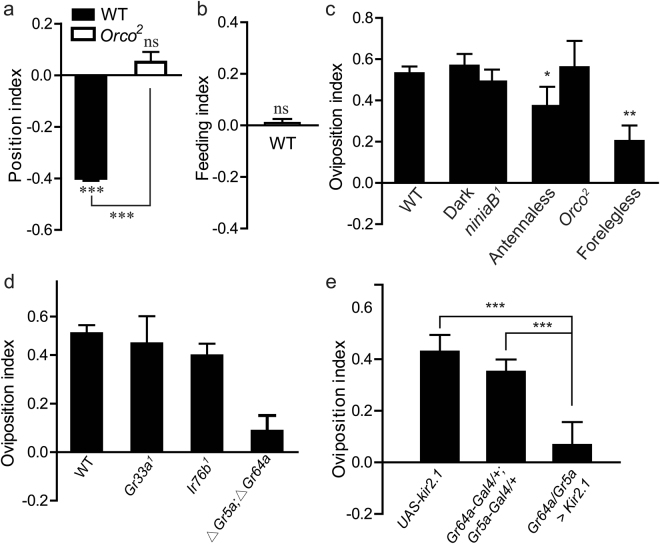Figure 2.
Role of gustatory system and sucrose receptor neurons in oviposition choices. (a) The positional preference for fermentation. Wild-type (WT) flies were averse to a fermented fly food, while Orco 2 mutants deficient in odor were neutral. Females were presented the following 2-choice as depicted in Fig. 1a, and position was examined. The one-sample t-test was used to assess the mean deviance of each column from 0; ANOVA tests with LSD post hoc analysis were used to calculate significance differences between columns; n = 28–46. (b) The feeding preference for fermented food. Females were presented the following 2-choice food combinations, and one half food was supplemented with dye. After feeding, the amount of dye in fly gut contents was quantified. The one-sample t-test was used to assess the mean deviance of each column from 0; n = 8. (c) Screening of candidate sensory modalities for oviposition selection for fermentation. The indicated animals were allowed to choose using two-way food preference assays. For vision, WT flies in darkness and ninaB 1 were used; for olfaction, antennaectomized females (surgically removing the primary olfactory organs) and Orco 2 mutants (unable to respond to most olfactory stimuli) were used; for gustation, the forelegs that contain gustatory sensilla were surgically ablated. ANOVA tests with LSD post hoc analysis, n = 6–12. (d) The role of Gr5a; Gr64a neurons in the oviposition preference for fermentation. Gr33a 1 mutants, IR76b 1 mutants and ΔGr5a; ΔGr64a double mutants were used, and the oviposition index was evaluated. ANOVA tests with LSD post hoc analysis, n = 8–15. (e) Hyperpolarizing Gr5a and Gr64a neurons reduced the oviposition preference for fermentation. Animals carrying Gr64a-GAL4;Gr5a-GAL or UAS-Kir2.1 were used as a negative control. Mann-Whitney Test, n = 5–8. Mean ± SEM. Symbols: NS p > 0.05; *p < 0.05; **p < 0.01; ***p < 0.001.

